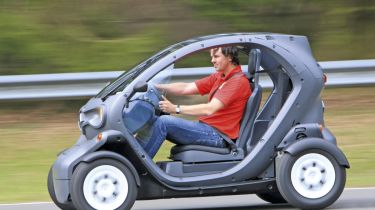Renault Twizy
We find out if Renault's pioneering, all-electric car is a real city slicker in an exclusive first drive.
The Twizy is a genuinely exciting package for city streets. The compact size makes it easy to park and perfect for negotiating busy roads. And, when you want it to be, it’s actually a lot of fun to drive. The range should be more than long enough to cover most people’s commutes, and the quick recharge time is a big bonus. Renault’s potential buyers are owners of three-wheeled scooters looking to swap into a safer, more practical form of transport. There’s no reason why the Twizy won’t appeal to those motorists, as well as city-based drivers keen to trade in their car for something a little different.
The future is here, and Auto Express has driven it! Renault’s Twizy is promising to revolutionise the way we negotiate crowded city streets when it arrives in March next year, but will it deliver?
The Twizy certainly looks like nothing else on the road. Measuring only 2.32 metres long (a Smart ForTwo is 2.69 metres), 1.19 metres wide and 1.46 metres high, it’s designed to nip around town like a scooter, but with the added protection of doors, a roof and four wheels.
[[{"type":"media","view_mode":"content_narrow","fid":"69318","attributes":{"alt":"","class":"media-image"}}]]
Renault’s family face even makes an appearance, with the headlights and large diamond badge mounted in a full-width grille. The cabin is basic, with a few buttons for selecting forward or reverse, and a large readout displaying speed and range. There’s plenty of room for the driver, but the rear seat, which is mounted directly behind, is cramped for adults. Underneath the rear seat is a 31-litre lockable cubby, which can carry small bags.
Power comes from a 15kW – or 20bhp – electric motor that also produces 57Nm of torque. From a standstill, the Twizy, helped by a responsive throttle, boasts an impressive turn of pace and will accelerate all the way to 50mph. In Europe, Renault will offer a lower-powered Twizy with only 5.4bhp and badged 45, in reference to its top speed of 45km/h (28mph).
This model doesn’t require a driver’s licence in some countries, but company sources suggest we won’t see this variant in the UK. In either version, the silent progress and lack of gears make for a relaxing drive at low speeds. Push the Twizy above 30mph, though, and there’s a lot of wind noise. That’s down to the fact that our prototype wasn’t fitted with doors – buyers will be able to choose half-height or full-height doors.
The good news is that the 450kg Twizy is great fun to drive. The direct and responsive steering makes negotiating tight city streets a breeze. However, we could easily see a cold, rainy day ruining the fun somewhat – the Twizy doesn’t have an internal heater and the only protection from the rain comes from a waterproof cover, which stretches across the bottom of open-sided models.
Renault has confirmed a starting price of 6,995 Euros on the Continent, but that’s for the lower-powered, and doorless, Twizy. Expect a starting price tag of closer to £7,000 when it hits UK roads. Unfortunately, as it will be classed as a quadricycle – in the same way as the G-Wiz – the Twizy isn’t included in Government plans
to subsidise electric-car buyers.
Thatalso means it doesn’t have to face the same crash safety tests as other vehicles, although Renault claims a deformable crash structure and driver airbag will keep occupants safe. As with the rest of the firm’s all-electric Z.E range, customers will be required to pay around £40 a month to lease the batteries.
Owners will make back some of that money through cheap recharging, which should cost around £1 for a full top-up. The process takes 3.5 hours from a household socket. On a single charge, the Twizy will travel a maximum of 72 miles, but Renault admits that in stop-start traffic, and with aggressive driving, that figure can fall as low as 34 miles.
With a price tag higher than a two-wheeled scooter – but without the traffic-skipping ability – the Twizy could be a hard sell. But zero emissions, coupled with added safety and practicality, could lure riders into Renault’s baby.







